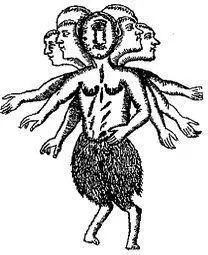The anesthetists were monkeys and dwarfs, dressed for carnival.
ORIGIN OF THE VACCINATION

At the beginning of the eighteenth century, smallpox killed half a million Europeans a year.
That was when Lady Mary Wortley Montagu, wife of the British ambassador in Istanbul, tried to get Europe to adopt Turkey’s tried and true method of prevention: a drop of variolic pus immunized against the murderous plague. But people mocked a woman masquerading as a scientist and preaching chicanery from pagan lands.
Seventy years later, an English doctor, Edward Jenner, inoculated the son of his gardener, an eight-year-old, with the so-called cowpox, which devastated the herds but did humans little harm. And then he gave him the deadly smallpox. The child did not fall ill.
Thus the vaccination was born, owing its existence to a child of servants used as a laboratory guinea pig, and owing its name to the Latin word for cow, vacca .

In 1576 a plague caused a conflict between Archbishop Carlo Borromeo, a sinner on his way to sainthood, and the governor of Milan.
The archbishop ordered his followers to gather in the churches and beg God to pardon the sins that had brought the plague upon them. But the governor prohibited any gathering in closed buildings to avoid contagion.
So Archbishop Borromeo invented the procession. He ordered the saints and all their relics taken from the churches and carried through the city streets on the shoulders of the crowd.
A sea of lilies, tapers, and angels’ wings stopped at the door of every church to sing hymns of praise to the virtuous of Christendom, and to perform scenes from their lives and miracles.
Thespians died of envy.

In Milan, Archbishop Borromeo deplored that “this adulterous, ungrateful world, enemy of God, this blind and crazy, ugly and pestiferous world,” had submitted to the masked lasciviousness of pagan festivals.
And he passed sentence on masks:
“Masks deform the human face and thus profane our divine likeness to God.”
In the name of God, the Church outlawed them. In the name of freedom, some time later, Napoleon did the same.
The masks of commedia dell’arte found refuge among the puppets.
With four sticks and a rag, puppeteers put on their tiny shows in public squares shared with acrobats, drifters, wandering minstrels, storytellers, and carnival magicians.

And when the masked puppets’ mockery of the lords and ladies got out of hand, the police whacked the puppeteers with their nightsticks and hauled them off to jail. And the puppets were left abandoned, gloves without hands, in the dark and empty square.

African masks will not make you invisible. They neither hide, nor disguise, nor mask.
The gods that founded our earthly life in Africa send masks to transmit energy to their children. The mask with bull’s horns gives strength, the one featuring antelope antlers offers speed, the one with an elephant’s trunk teaches resistance, the one that has wings makes you fly.
Whenever a mask breaks, the mask-maker carves a new one. The mask’s spirit will not be left homeless, and the people will not be left helpless.

The word “pasquinade,” meaning a libelous lampoon, comes from a statue in Rome. On the breast or back of that marble personage named Pasquino, anonymous hands wrote homages to the popes.
• On Alexander VI:
Alexander sells the nails and he sells Jesus crucified.
There’ll be no challenge to those sales: Al bought the goods before He
died.
• On Leo X:
Dead is the tenth of the Pope Leos,
well-known for the affection he had
for knaves and false impresarios
for tyrants rotten, dishonest, and bad.
• On Paul IV:
More faith, my children, and much less thought,
the Holy Office says a lot.
And there’s no reason they need name,
since to extinguish reason they have flame.
And keep your tongues hidden, don’t let them be viewed,
’cause Pope Paul likes them barbecued.
• And this is what the statue of Pasquino said to Pope Pius V, who sent quite a few suspected writers of pasquinades to the stake:
The gallows, oh, and the slow fire,
all the torments you desire,
frighten me not, Pius my dear.
You can send me to the stake
but shut me up you cannot make.
Of stone I’m made. I laugh, I sneer.
For you I am a threat to fear.
RECORD OF THE DEVIL’S CONFESSION

He had been decrepit since childhood.
Charles II, king of Spain and of America, was over thirty yet he had to be spoon-fed and he could not walk without falling down.
Useless were the dead pigeons the doctors placed on his head, and equally useless the capons raised on snake meat that his servants put down his throat, the cow’s piss they gave him to drink, and the scapularies stuffed with fingernails and eggshells slipped under his pillow by the friars who watched over his sleep.
Twice they married him off and no prince was born to either queen, even though both breakfasted on donkey’s milk with extract of agaric mushroom.
At that time the devil lived in Asturias, inside the body of a nun in the convent at Cangas. The exorcist, Father Antonio Álvarez Argüelles, extracted this confession:
“It is true that the king has been cursed,” the exorcist said the nun said the devil said. And the hex had been carried out with the remains of a cadaver.
“Using brains to disarm his ability to lead. Using entrails to destroy his health. Using kidneys to keep him from siring.”
And the exorcist said the nun said the devil said the author of the evil deed was a woman. The king’s mom, to be precise.

Teresa of Ávila entered the convent to save herself from hell, the conjugal hell. Better to be a slave to God than servant to a brute.
But Saint Paul gave women three rights: “to obey, to serve, and to remain silent.” So the representative of His Holiness the pope found Teresa guilty “of being an apprehensive and unsettled female, disobedient and contumacious, who under the guise of devotion invents evil doctrines against Saint Paul, who commanded women not to teach.”
In Spain, Teresa founded several convents where the nuns not only gave classes but were in charge, where virtue was prized and lineage worthless, where no one had to submit proof of clean blood.
In 1576 she was accused before the Inquisition, because her grandfather claimed to be a true Christian but was a converted Jew, and because her mystical trances were the work of the devil ensconced in her body.
Читать дальше




















